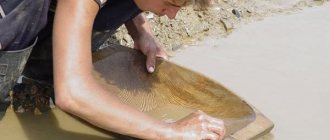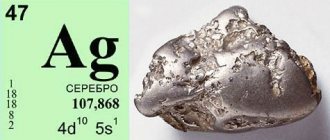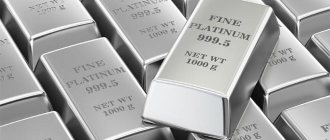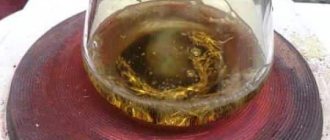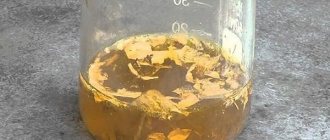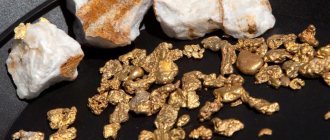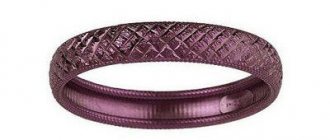The origin of gold still remains a mystery. Many scientists come to the conclusion that gold is of cosmic origin. But this theory is incomplete, since the relationship of gold to water was noted - it is at the bottom of rivers and reservoirs that the precious metal can be found. Even in sea water, gold can be found in the form of colloidal particles. How to find gold in streams and rivers is a question that worries not only scientists, but also miners who are looking for ways to get rich.
Searching for gold in the streams
Where do miners find gold in Russia?
The largest Au deposits are located in the Far East and Eastern Siberia. The third place is occupied by the Urals.
Below is a list of rivers containing the largest reserves of the yellow metal - this is where I recommend finding and washing it.
Yellow metal satellites
Companion rocks that play the role of “witnesses”, suggesting that gold-bearing veins are somewhere nearby:
- silver;
- pyrite;
- quartz;
- lead;
- galena.
Pyrite is the most insidious companion of gold, because beginners often cannot distinguish it from a real noble metal: they find a mass of pyrite crystals and rejoice at the happiness that has fallen on their heads, and then they are disappointed.
Meanwhile, gold can not only be washed from the river, but also found inside inconspicuous-looking pieces of rock scattered along the shore. If a piece of mineral glitters with a yellow tint that does not change when light is refracted, there is most likely gold inside. This breed should be crushed and washed.
Why do they wash gold in the river?
Extracting gold from the river is the most accessible way for single miners to get hold of the precious metal. To find it in river beds and wash it out of rock, you do not need to purchase expensive equipment and hire personnel, as with industrial mining from the subsoil.
There is definitely Au in the rivers flowing near gold deposits; there is a simple popular scientific explanation for this. Temperature changes and other natural phenomena destroy gold-bearing ores, small particles of the precious metal are washed away by rain, melt and flood waters into rivers and streams. After which, being heavy, gold settles in certain places:
- terrace deposits are found on rapids and sills that rise above the level of the banks of watercourses, as well as in dry riverbeds;
- Bottom placers should be looked for in bedrock channels (in valleys);
- spit deposits are formed on river spits, whether sandy or pebbly.
It is good to find and wash small gold grains and large or small nuggets in bedrock, places where the flow of water slows down (the mouths of mountain streams, turns of riverbeds), natural “traps” (near boulders lying in a mountain river, on shallows, in pits under waterfalls, near fallen trees blocking the river flow).
Types of deposits
The most popular gold deposit is quartz, the veins of which nature created many years ago. Over time, the veins experienced the influence of various natural factors, and as a result, the gold floated into the rivers. Gold survived the impact of stones that crushed and polished it. Due to its weight, it was deposited in the ducts. Geologists can determine the history of a particular sample and its proximity to the vein with just a glance.
The search itself is carried out using trays - they sift through the top layer of the river bottom. When sifting through the water, gold grains remain on the mesh of the tray. The technology is as simple as possible, but requires monotonous and long work. Searching for gold in streams can only be effective with proper preparation of the seeker, who is committed to hard prospecting work. Knowledge of the characteristics of the metal and the skills of searching and mining the mineral will definitely help to improve your financial situation, with, of course, the favor of good luck to the seeker of the precious metal.
Is it possible to mine gold in Russia?
Until 2021, only large legal entities had the right to engage in gold mining. The activities of private miners who dared to wash the precious metal were completely illegal and criminally punishable.
Currently, private individuals have the right to extract gold from deposits - under two conditions:
- individual entrepreneur registration;
- availability of a license or agreement with a gold mining organization that has all the permits for the development of gold mines.
Obtaining a license is a long and troublesome procedure; concluding an agreement with a licensed gold mining company is a much simpler path.
Industrial mining of precious metals brings companies quite high incomes. And private miners who want to pan for gold using the artisanal method are not competitors for them. So we can reach an agreement.
What laws regulate gold mining?
Business entities have the right to engage in gold mining in the Russian Federation, guided by the federal law “On Subsoil”, after the adoption of a number of amendments allowing both legal entities and individual entrepreneurs to mine gold from the beginning of 2021. Any private miner is given the opportunity to rent a plot of land of up to 0.15 square meters for a specified period, which is enough to extract up to 10 kilograms of precious metal.
A few more conditions must be met:
- obtain metal only by surface method;
- exclude the use of explosives;
- take soil only up to 5 meters deep.
If you wash precious metals without a license or an agreement with a company that has one, this activity is still punishable under Art. 191 of the Criminal Code of the Russian Federation. And violation of these requirements threatens with serious sanctions.
Permitted Miner's Tools
Tools that help you find and wash precious metals:
- Mini-drag for pumping rock from the bottom of the river (no deeper than 5 m) and washing it away.
- A tray in which it is convenient to wash the rock by hand.
- A metal detector that detects the presence of metal in the soil. A conventional device reacts not only to gold, but also to any metal, so I advise you to use a special metal detector with a sensor that can be easily configured specifically to search for gold.
What is a tray and why do you need a magnet?
A tray is a special device for washing rock and separating Au from it. With it you can do without a mini-dredge and get soil out of the river with an ordinary shovel.
The magnet helps separate black sand from base metals from Au.
In addition to the tray and magnet, I advise you to purchase a bulb bottle, which helps you easily remove precious particles from the tray at the last step of lathering.
It is more convenient to place gold grains in a glass bottle.
Why flushing?
Lucky catch
When and by whom exactly this technology for laundering precious metals and the trays themselves for washing gold were invented, historians find it difficult to say for sure. There are a variety of versions about the emergence of this method of gold mining, which is used in different parts of the globe. Some peoples have legends that ancient deities gave people the knowledge of how to mine yellow precious metal. It is quite natural: most of these tales and legends are associated with the cult of the Sun, whose element is gold.
The ancient peoples had no other technologies for extracting gold from ore, except for washing. But even ancient scientists expressed a version: gold has the ability to “hide” in stones, and the one who learns the secret of extracting it from there will become the richest of mortals. It is from there that the legends about the “philosopher’s stone” that became widespread in medieval Europe take their origins.
It was believed that he was capable of turning any mineral into gold. Over time, the “philosopher’s stone” became a symbol of the pursuit of wealth, the search for scientific and spiritual discoveries. The origins from which the legend came to the Middle Ages were forgotten. But thoughts about new ways to extract gold from ore continue to occupy people's minds.
How to properly wash gold with a tray
Now that we've sorted out the tools, I'll describe the technology for panning gold by hand.
It consists of three washing stages:
- large rocks and dirt;
- gravel and ordinary sand;
- black sand.
Washing away dirt and large rocks
- Fill the tray three-quarters full with rock, dip it into the stream so that the edges are above the surface of the water.
- Shake the tray back and forth and left and right, sharply but gently, without shaking out the gravel.
- After several shakes, we rotate the tray, moving the gravel in a circle, while most of the dirt inside dissolves.
- We remove the moss and roots and rub them over the tray with our fingers, checking to see if there are any gold particles in them.
- We take out large stones and check if they are washed.
We continue to wash with shaking and circular movements until large rocks and dirt are removed.
Washing out sand and gravel
- Holding the tray above the water surface, tilt it slightly away from you.
- We rotate it, shaking it from time to time in an upward motion, as if tossing a steak in a frying pan, but without throwing out the gravel and not letting it wash over the edge.
- Shake the tray (still in water) back and forth.
- Repeat steps 1-3 to thoroughly rinse the contents of the tray until only heavy rock remains at the bottom.
It consists of black sand, which, if the miner is lucky, contains grains of gold.
Washing out black sand
- We take the tray out of the watercourse. We do not pour out the water remaining at the bottom; it will be useful at the last stage of washing.
- We tilt the tray a little and slowly turn it in a circle, checking if there are any precious pieces of gold or small nuggets at the bottom. If there is any, remove it and put it in a container for storing the “catch”.
- Slowly pass a magnet over the black sand. Black sand sticks to it, separating from the golden grains.
- We take a pear bottle, squeeze it and, unclenching it, suck up the gold and water from the tray.
- Pour the remaining black sand and gold grains into a container for precious metal.
You can finish washing and cleaning black sand, extracting the smallest Au particles from it, at home.
Non-industrial extraction methods
So, gold has been found, but most often gold nuggets have impurities, for example, silver or quartz. Or during mining you get too small particles of gold mixed with sand or concentrate. In order to extract gold without the use of industrial equipment, there are three main ways:
- amalgamation with mercury;
- cyanidation;
- chlorination.
The first method is used if the gold fractions do not exceed a millimeter in diameter. The technology is simple: the metal is dissolved in mercury and an amalgam is obtained. Then the rock is separated using a fine mesh. About half of the resulting solution contains gold; it is obtained by evaporating the solution. Now this method is not very often used due to the fact that the gold obtained is not very pure, and also because mercury fumes are very harmful to humans.
The second method involves leaching, concentration and purification of the metal. Leaching occurs due to the interaction of cyanide with oxygen, after which the concentrate is removed using activated carbon, filtered and calcined. In this case, it is possible to obtain a purer metal, but cyanide vapor is even more dangerous than mercury vapor. In essence, zoning is a hydrometallurgical process. At first, only potassium cyanide was used for this method, then they also switched to calcium cyanide. In addition, it was found that fine crushing gives better results compared to coarse crushing.
The third method involves the use of hydrochloric acid and chlorine, which dissolve the gold, after which it is fused into an ingot.
Choosing a place to wash gold
Tips on how to choose the best place to extract the richest rock from the water and wash the yellow metal with the greatest benefit:
- Search on a river or in a stream from the list of the most “gold-bearing” ones, not far from the place of industrial mining - after it, not only the smallest grains of gold remain, but also whole nuggets, which are enough for everyone.
- Choose a section of the watercourse with a depth of more than 15 centimeters so as not to wash the metal in too dirty water full of small debris.
- Choose a section of the river with a relatively slow (slow) flow.
- If you're lucky, find a place with a large stone or a fallen tree where you can sit down so as not to wash the precious metal while standing.
What is the production volume?
Beach hunting for gold is tempting, so dozens of newcomers want to join the ranks of those who want easy enrichment. However, the question of profit remains open: how much can you earn using the simplest devices and can searching for gold on the beach actually become a source of income?
The main source of loot is coins lost by people relaxing on the beach. In the language of professional prospectors, they are called “walkers.” They fall into the sand the moment a person takes off his clothes - as a result, coins of various denominations spill out of his pockets. Such finds, for the most part, represent metal money in denominations of 1-2 rubles; modern iron tens are also found. In general, it’s a trifle, but sometimes you come across truly valuable things - commemorative coins that are valuable to collectors.
When actively searching for gold along various beaches or near recreational areas in the city, it is better to start by watching training videos that explain in detail the rules of working with a metal detector. Such an activity is not only an interesting pastime, but also a source of small income.
The main goal and main task of any “search engine” is jewelry, products with precious stones and simply things that have value for subsequent resale.
On the beach you can find chains and rings, bracelets and, of course, rings. Based on the calculation that 1 gram of gold costs about 1000 rubles in a pawn shop or pawnshop, a simple ring can bring an average of 2 – 2.5 thousand. Accordingly, if you manage to find a bracelet, then the revenue will be much greater, so the jewelry “destination” on the beach is most popular among hunters for precious metals, but do not forget about the licensed casino and its competitors. Thus, you can make good money by searching for gold in your free time.
Top 10 Russian rivers rich in gold reserves
The Golden Ten watercourses, where there are a lot of reserves and it’s profitable to wash:
- Alekseevsky stream (Kamchatka);
- Bodaibo River (Irkutsk region);
- tributary Bolshoi Chanchik (ibid.);
- Bom River (Amur region);
- Jalon stream (ibid.);
- the Lena River and its basin;
- Millionny stream (Amur region);
- Unakha River (ibid.);
- Sanarka River (Chelyabinsk region);
- Talga River (Khabarovsk Territory);
At Bodaibo and Millionnoye they wash the rock and extract the largest gold particles. Nuggets are also found in these and other watercourses.
The further fate of gold mining
Many scientists are struggling to find a new source for the precious metal because, according to some estimates, gold reserves will run out within half a century. One of the most promising methods is gold leaching.
A progressive method of mining from the bottom of the Bering Sea.
In addition to chemical methods, the development of the water element - the ocean - can help discover new deposits. Sea gold deposits are quite common, not to mention the ocean floor, about which little is known. It is likely that there, under water, there are rich reserves of the precious metal.
We also recommend that you read our article about the features of gold mining in Russia.
Search algorithm
Stages of hunting for precious metal deposited in the river:
- Valley exploration.
- Check the current - the stronger the current, the more gold can be found in places where it slows down.
- Drawing up a route along which to search.
- Hiking along the shore, searching for satellite rocks, and with them gold itself.
Necessary tool
The equipment of a gold miner includes a metal detector (metal detector) and a mini-dredge or a tray for washing rock.
You also need full equipment for going to the area where you are going to search and mine gold.
